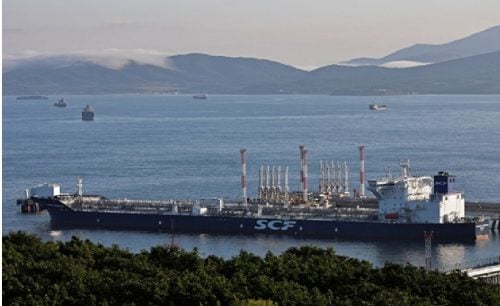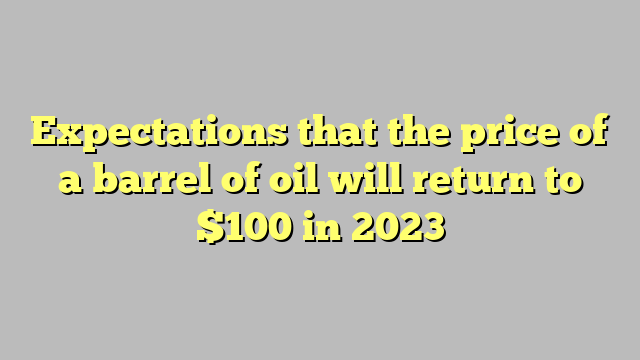Read in this article
- OPEC+ and OPEC do not publish oil price forecasts and do not have a price target
- Officials and ministers from OPEC and OPEC+ are often reluctant to formally discuss price direction
- Oil may rebound to around $100 in the second half of the year
- The OPEC+ alliance is likely to maintain the current production policy at its next meeting
Officials and ministers from OPEC and the OPEC+ alliance are often reluctant to formally discuss the direction of the price of a barrel of oil globally, and both sides do not publish price forecasts, stressing that they do not have a target price.
But Iran’s representative to OPEC, Afshin Javan, said oil prices could rebound to around $100 in the second half of the year.
In rare public comments, Afshin Javan said that the OPEC+ alliance is likely to maintain the current production policy at its next meeting, Reuters reported.
And in 2022, the price of a barrel of oil exceeded $100 for the first time since 2014, with demand recovering from COVID-19 lockdowns in most parts of the world, and the Russian invasion of Ukraine adding to supply concerns, according to information monitored by the specialized energy platform.
In contrast, Brent crude ended last year near $86 on fears of a global recession.
Oil price forecasts in 2023
Energy platform editing advisor, energy economics expert Dr. Anas Al-Hajji, said that there are those who hope that oil prices will rise in the current year (2023) above the $100 level.

Al-Hajji explained – during an episode of the program “Energy humanitiesHe presented it on Twitter under the title “Oil Markets Outlook for 2023” – that a report published by “Substack” on energy market expectations for the current year said that the first half of the year is completely different from its second half.
Dr. Anas Al-Hajji added: “All expectations see that the oil market is weak during the first half of (2023), but there is great optimism during the second half, and there are many reasons for this view, some of which differ from one company to another, but there are general reasons.”
The return of the price of a barrel of oil to above $100 for a long time will bring more revenues to OPEC members, whose economies mostly depend on oil income, and it will be a setback for industrial economies that are trying to control inflation and interest rates.
To support the market, the Organization of the Petroleum Exporting Countries (OPEC) and its allies, including Russia, in the alliance known as OPEC +, agreed in October (2022) to cut production by two million barrels per day, or about 2% of global demand, according to the agency. Reuters.
OPEC + decisions
The OPEC+ Joint Ministerial Monitoring Committee, during its last meeting, reviewed crude oil production data for November and December 2022, and noted full compliance with the Declaration of Cooperation.
The members of the committee reaffirmed their commitment to the declaration of cooperation that extends until the end of 2023, as agreed upon at the 33rd ministerial meeting on October 5, 2022, according to a press release seen by the specialized energy platform.
They also urged all participating countries to achieve full compliance and abide by the compensation mechanism.
The next ministerial meeting is scheduled to take place on June 4, while the Joint Ministerial Monitoring Committee will meet on April 3, according to a report published by the specialized energy platform on February 1.
Factors for the rise in the price of a barrel of oil
After the volatility of 2022 pushed Brent crude near all-time highs of $147 shortly after the Ukraine war began, so far in 2023 Brent has risen to just over $86, aided by Russia’s plan to cut production in March. March.
The consensus in the industry is currently centered on a lower price per barrel of oil in 2023, compared to the average price of 2022.
A Reuters survey of 30 economists and analysts predicted that Brent crude would average $89.37 a barrel in 2023, down from $99 in 2022.
For its part, US investment bank Goldman Sachs lowered its forecast for Brent crude for 2023 to $92.
Analysts are likely that the sudden lifting of Chinese restrictions to combat the emerging corona virus will enhance oil demand growth in 2023, after it was estimated that the country recorded a slight decrease in 2022 for the first time in years.
OPEC sources see a lack of investment to raise prices to support supply, as OPEC members pump nearly 1 million barrels per day below target, according to the organization’s figures and other estimates.
Despite expectations that non-OPEC producers will pump more in 2023, the forecast for an increase of 1.5 million bpd falls short of expected demand growth of 2.2 million bpd, according to OPEC forecasts.
Another OPEC source said: “Even with the arrival of additional supplies from here and there, the market will continue to witness a shortage of supply compared to demand, as there is more upward pressure than downward pressure on the market.”

Russia production cuts
The OPEC+ cut agreed in October applies to the whole of 2023, and International Energy Agency director Fatih Birol on February 5 urged producers to reconsider their production policies “if demand picks up sharply”.
Birol said last November that the $100 price of a barrel of oil poses a real threat to the global economy.
For their part, the main OPEC+ ministers, at the February 1 meeting, endorsed the current policy, after which, a source said, the main message is that the OPEC+ alliance will continue the course until the end of the agreement.
Two OPEC + delegates told Reuters on Friday, February 10, that OPEC + will not take any action after Russia announced production cuts.
Another OPEC source agreed that oil prices could return to $100 in 2023, although economic growth prospects were the main risk.
“Everything will depend on the economy, if there is an improvement in China we might go back to $100,” he said, adding that crude oil prices between $85 and $100 are “good for everyone.”
In addition to recession risks, OPEC sources – who envision a lower oil price per barrel in 2023 – said it was unclear how much demand would come from China and whether it would impose lockdowns again to contain the coronavirus outbreak.
“There are still uncertainties about economic growth, inflation and China’s reopening,” said the second OPEC source, who expects lower prices this year.
Also read..

Leave a Reply